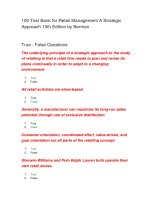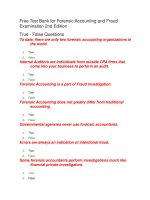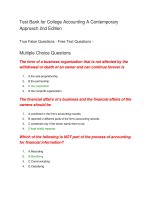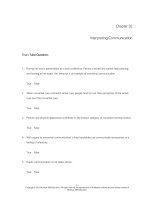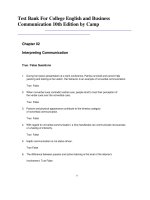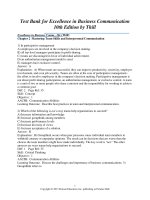Test bank for college english and business communication 10th edition by camp
Bạn đang xem bản rút gọn của tài liệu. Xem và tải ngay bản đầy đủ của tài liệu tại đây (373.53 KB, 36 trang )
Test Bank For College English and Business
Communication 10th Edition by Camp
Chapter 02
Interpreting Communication
True / False Questions
1. During her boss's presentation at a work conference, Patricia is bored and cannot help yawning
and looking at her watch. Her behavior is an example of nonverbal communication.
True
False
2. When nonverbal cues contradict verbal cues, people tend to trust their perception of the verbal
cues over the nonverbal cues.
True
False
3. Posture and physical appearance contribute to the kinesics category of nonverbal
communication.
True
False
4. With regard to nonverbal communication, a limp handshake can communicate nervousness or a
feeling of inferiority.
True
False
5. Haptic communication is not status-driven.
True
False
6. The difference between passive and active listening is the level of the listener's involvement.
True
False
2-1
7. External noise includes sounds from conversations, radios, televisions, CD players, machinery,
and so on.
True
False
8. Having preconceived thoughts and opinions when listening to a talk is an example of a listening
barrier.
True
False
9. One reason listeners stop paying attention is that they hear faster than most speakers can
speak.
True
False
10. Paraphrasing refers to the organization of paragraphs in a textbook.
True
False
11. While listening to a lecture, highlighting major points in your notes defeats the purpose of taking
notes.
True
False
12. Typing and printing your notes will make them easier to read, but this process will not help you
learn the material.
True
False
13. The ability to read quickly is important in our productivity-oriented business world.
True
False
14. When reading technical material filled with new concepts and vocabulary, it may be necessary to
read the material two or more times to fully comprehend it.
True
False
15. One way to organize your reading notes is to make an outline.
True
False
Multiple Choice Questions
2-2
16. Which of the following is NOT an example of nonverbal communication?
A. Maintaining eye contact
B. Facial expressions
C. Asking questions
D. Taking notes
17. _____ is nonverbal communication through factors such as tone, pitch, quality, rate of speech,
laughter, tears, belches, and even hesitation or sighs.
A. Environment
B. Kinesics
C. Paralanguage
D. Haptic communication
18. Body language is also known as _____.
A. verbal communication
B. paraphrasing
C. haptic communication
D. kinesics
19. Andrea has been finding it difficult to perform at work recently. Deborah, her boss, is concerned
and calls her in for a one-on-one meeting. In the meeting, Andrea admits that she is going
through a tough time because she is in the middle of a divorce. While talking, Andrea gets
emotional. To demonstrate her understanding, Deborah reaches out and pats Andrea's hand.
This action from Deborah is an example of:
A. verbal communication.
B. paralanguage.
C. kinesics.
D. haptic communication.
20. In the context of space, as it relates to nonverbal communication, the distance of 3 feet to 7 feet,
used in the workplace for business-related conversations and small meetings, is known as:
A. social distance.
B. intimate distance.
C. personal distance.
D. public distance.
2-3
21. Which of the following is true of passive listening?
A. It is appropriate only when you listen for pleasure.
B. It requires a high level of concentration.
C. It is most appropriate in school or in the workplace.
D. It enhances the ability of a listener to retain vital information and signals.
22. In the listening model, interpreting is the act of:
A. filtering out distractions to allow you to comprehend the meaning of sounds.
B. using retained and analyzed sounds.
C. remembering analyzed sounds for later use.
D. analyzing the sounds that you comprehended.
23. Dan had been nominated for a seminar on how to be a better manager. The night before the
seminar, he had to stay up all night because his daughter was unwell. During the seminar, he
was unable to listen attentively to the speaker due to concerns about his daughter's health. In this
scenario, Dan's listening was affected by:
A. internal noise.
B. external noise.
C. red noise.
D. flicker noise.
24. Which of the following is considered to be a listening barrier?
A. Using filters while listening
B. Interrupting the speaker
C. Making eye contact with the speaker
D. Paraphrasing the content presented to you by the speaker
25. Which of the following helps you retain the content of a speaker's message?
A. Sit facing away from the speaker.
B. Take minimal notes.
C. Ensure that the speaker knows whether you agree or disagree with him or her at every step of
the speech.
D. Identify the speaker's ideas and the connections among the ideas.
2-4
26. Paraphrasing _____.
A. involves putting the speaker's ideas into the simplest, clearest, and most direct words possible
without changing the intended meaning
B. refers to the way paragraphs are organized and the mandatory rules of punctuation followed
while writing an essay
C. involves converting what the speaker says into what the listener wants to say
D. refers to inconsistent indentation styles that are usually seen in an informal written document
27. Imagine that your manager wants to talk to you about a project. Identify the nonverbal cue that
you can use to let your manager know that you are listening to him or her.
A. Stand or sit facing away from your manager to help him or her feel more comfortable.
B. Do not take notes while talking to your manager because it gives the impression that you are
distracted.
C. Give the manager your undivided attention so that he or she is comfortable.
D. Ensure minimum eye contact with your manager while he or she is talking.
28. Rick is attending a training session on communication skills at work. The session is being
conducted by a famous life-skills coach from another country. Rick is distracted by the speaker's
accent and style of speaking because it is so different. In this situation, which of the following
actions should Rick take to ensure that his listening is maximized?
A. He should maintain his mental focus on the speaker's message.
B. He should turn away from the speaker so that he can listen more carefully.
C. He should leave the training session.
D. He should maintain less eye contact so that he can listen more actively.
29. Which of the following is a useful tip on taking lecture or meeting notes?
A. Do not write notes directly on handouts.
B. Try and take down everything the speaker says.
C. Ask questions if permitted.
D. Do not leave any margins or empty spaces in your notes.
2-5
30. Fergie is attending a training session conducted by a senior executive at work. The room that the
session is being conducted in is very large and brightly lit. To ensure that she gains the most from
the session, Fergie should choose a seat:
A. at the front and center of the room.
B. in a location amidst distracting sights and sounds.
C. in a dark area if the room has inconsistent lighting.
D. at the back of the room.
31. Which of the following is NOT a tip on taking lecture or meeting notes?
A. Listen for cues that something is important.
B. Leave a wide left-hand margin in your notes.
C. Use complete sentences, not phrases.
D. Begin a new page for each meeting or session.
32. Which of the following is a strategy for previewing reading material?
A. Do not get distracted by the table of contents, headings, and other features.
B. Read each sentence carefully and make notes while doing so.
C. Read the first paragraph of the chapter, section, or article.
D. Do not get distracted by illustrations.
33. Where is the main idea of a written paragraph usually found?
A. In the third line of the paragraph
B. In the footer
C. In the topic sentence
D. In the header
34. Which of the following is a tip to follow when taking reading notes?
A. Use complete sentences.
B. Always take verbatim notes.
C. Do not use abbreviations.
D. Use pen rather than pencil.
2-6
35. _____ is a way of delivering education or training anytime and anyplace.
A. Distance learning
B. Classroom training
C. Vestibule training
D. Close-to-the-job learning
Fill in the Blank Questions
36. Sharon's boss is giving her some feedbacks about her missed deadlines over the past few
months. Sharon is not open to feedbacks and sighs at repeated intervals because she is resistant
to what her boss is saying. Sharon's nonverbal communication is an example of _____.
________________________________________
37. _____, as it relates to nonverbal communication, is the physical distance maintained with others.
________________________________________
38. For North Americans, the distance of 18 inches to 3 feet, used for casual and friendly
conversations, is known as _____.
________________________________________
39. A handshake is an example of _____ communication.
________________________________________
40. _____ is hearing something with thoughtful attention.
________________________________________
41. The physical function of detecting sound is called _____.
________________________________________
42. In the listening model, _____ is the act of using retained and interpreted sounds.
________________________________________
2-7
43. A(n) _____ is a meeting held by means of advanced telephone and sometimes computer
technology that enables people from several locations to participate simultaneously.
________________________________________
44. _____ refers to understanding the content of the reading material.
________________________________________
45. _____ refers to remembering the content of the reading material.
________________________________________
Essay Questions
46. List and describe the five categories of nonverbal communication.
47. Explain with an example how you might convey conflicting signals while communicating with
another person.
2-8
48. Differentiate between hearing and listening with examples.
49. Explain the difference between passive and active listening. When is each type of listening
appropriate?
50. Discuss any five barriers to listening and how you could overcome them.
2-9
51. Lenny is attending a training session on how to achieve work-life balance. Discuss the steps he
can follow to ensure that he has retained the content of the speaker's message.
52. Discuss the ways in which you can prepare yourself physically and mentally to listen attentively to
a speaker at a training session.
53. List and discuss, with examples, five ways in which you can use nonverbal cues to show
speakers that you are listening to them.
2-10
54. List the five steps you should follow when previewing material before taking notes.
55. Describe the points to remember when you are rereading and reviewing your work.
2-11
Chapter 02 Interpreting Communication Answer Key
True / False Questions
1.
During her boss's presentation at a work conference, Patricia is bored and cannot help
yawning and looking at her watch. Her behavior is an example of nonverbal communication.
TRUE
Patricia looking at her watch is an example of nonverbal communication. Nonverbal
communication is communication without words.
AACSB: Communication
Accessibility: Keyboard Navigation
Blooms: Apply
Learning Objective: 02-01 Discuss the basics of nonverbal communication and their importance in all interactions.
Level of Difficulty: 2 Medium
Topic: Essential Principles
2.
When nonverbal cues contradict verbal cues, people tend to trust their perception of the verbal
cues over the nonverbal cues.
FALSE
When nonverbal cues contradict verbal cues, people tend to trust their perception of the
nonverbal cues. Therefore, even from the first impressions people form about you, through
personal and professional relationships as they grow, the nonverbal information you broadcast
will weigh heavily on your influence and impact on people.
AACSB: Communication
Accessibility: Keyboard Navigation
Blooms: Understand
Learning Objective: 02-01 Discuss the basics of nonverbal communication and their importance in all interactions.
Level of Difficulty: 2 Medium
Topic: The Importance of Nonverbal Communication
2-12
3.
Posture and physical appearance contribute to the kinesics category of nonverbal
communication.
TRUE
Physical attributes such as appearance, facial expressions, eye contact, and posture all
contribute to kinesics, or body language. Body language, or kinesics, is the gestures,
movements, and mannerisms by which a person communicates with others.
AACSB: Communication
Accessibility: Keyboard Navigation
Blooms: Remember
Learning Objective: 02-01 Discuss the basics of nonverbal communication and their importance in all interactions.
Level of Difficulty: 1 Easy
Topic: Categories of Nonverbal Communication
4.
With regard to nonverbal communication, a limp handshake can communicate nervousness or
a feeling of inferiority.
TRUE
A limp handshake can communicate nervousness or a feeling of inferiority; a firm handshake
communicates confidence. Touch, or haptic communication, is a primary method for achieving
connection with people, indicating intention, or expressing emotion.
AACSB: Communication
Accessibility: Keyboard Navigation
Blooms: Understand
Learning Objective: 02-01 Discuss the basics of nonverbal communication and their importance in all interactions.
Level of Difficulty: 2 Medium
Topic: Categories of Nonverbal Communication
5.
Haptic communication is not status-driven.
FALSE
Haptic communication is status-driven. That is, a manager may give an employee an
encouraging pat on the back, but not vice versa.
AACSB: Communication
Accessibility: Keyboard Navigation
Blooms: Understand
Learning Objective: 02-01 Discuss the basics of nonverbal communication and their importance in all interactions.
Level of Difficulty: 1 Easy
Topic: Categories of Nonverbal Communication
2-13
6.
The difference between passive and active listening is the level of the listener's involvement.
TRUE
There are two types of listening: passive and active. The difference between them is the level
of the listener's involvement.
AACSB: Communication
Accessibility: Keyboard Navigation
Blooms: Remember
Learning Objective: 02-02 Explain the mental and physical processes in listening.
Level of Difficulty: 1 Easy
Topic: Types of Listening
7.
External noise includes sounds from conversations, radios, televisions, CD players,
machinery, and so on.
TRUE
External noise includes sounds from conversations, radios, televisions, CD players,
machinery, and so on. Noise can affect your ability to listen.
AACSB: Communication
Accessibility: Keyboard Navigation
Blooms: Remember
Learning Objective: 02-02 Explain the mental and physical processes in listening.
Level of Difficulty: 1 Easy
Topic: Overcoming Listening Barriers
8.
Having preconceived thoughts and opinions when listening to a talk is an example of a
listening barrier.
TRUE
One of the barriers to listening is having preconceived thoughts and opinions. Listening
barriers are any distractions that interfere with listening.
AACSB: Communication
Accessibility: Keyboard Navigation
Blooms: Understand
Learning Objective: 02-02 Explain the mental and physical processes in listening.
Level of Difficulty: 1 Easy
Topic: Overcoming Listening Barriers
2-14
9.
One reason listeners stop paying attention is that they hear faster than most speakers can
speak.
TRUE
One reason we as listeners stop paying attention is that we hear faster than most speakers
can speak. The average person can speak 125 to 150 words a minute, but a good listener
processes 300 or more words a minute.
AACSB: Communication
Accessibility: Keyboard Navigation
Blooms: Remember
Learning Objective: 02-02 Explain the mental and physical processes in listening.
Level of Difficulty: 1 Easy
Topic: Overcoming Listening Barriers
10.
Paraphrasing refers to the organization of paragraphs in a textbook.
FALSE
One powerful and effective way of "owning" the content presented to you by a speaker is to
paraphrase the message. In doing so, the listener crystallizes her or his understanding of the
content, and the speaker has the opportunity to correct any discrepancies from the core of her
or his intended message.
AACSB: Communication
Accessibility: Keyboard Navigation
Blooms: Remember
Learning Objective: 02-02 Explain the mental and physical processes in listening.
Level of Difficulty: 1 Easy
Topic: Overcoming Listening Barriers
11.
While listening to a lecture, highlighting major points in your notes defeats the purpose of
taking notes.
FALSE
While listening to a lecture, use highlighting or underscoring to emphasize major points in your
notes. Some people have a tendency to color virtually the entire page with a highlighter. This
practice defeats the purpose of highlighting. Highlight only the major points. Some listeners
may use highlighter pens as they take notes; others will highlight after they take notes.
AACSB: Communication
Accessibility: Keyboard Navigation
Blooms: Understand
Learning Objective: 02-03 Discuss and contrast listening in casual and business settings.
Level of Difficulty: 1 Easy
Topic: Listening in Traditional and Teleconference Situations
2-15
12.
Typing and printing your notes will make them easier to read, but this process will not help you
learn the material.
FALSE
If the material is unusually hard to master, you may choose to key your notes and possibly
expand on them while the information is still fresh in your mind. Keying the information helps
you learn it, and having a neat printout makes your notes easier to read, study, and share with
others.
AACSB: Communication
Accessibility: Keyboard Navigation
Blooms: Understand
Learning Objective: 02-03 Discuss and contrast listening in casual and business settings.
Level of Difficulty: 1 Easy
Topic: Listening in Traditional and Teleconference Situations
13.
The ability to read quickly is important in our productivity-oriented business world.
TRUE
The ability to read quickly is important in our productivity-oriented business world. But even
more important than reading speed are comprehension and retention.
AACSB: Communication
Accessibility: Keyboard Navigation
Blooms: Remember
Learning Objective: 02-04 List suggestions for improving your reading skills.
Level of Difficulty: 1 Easy
Topic: Strategies for Comprehending and Retaining Content
14.
When reading technical material filled with new concepts and vocabulary, it may be necessary
to read the material two or more times to fully comprehend it.
TRUE
If the material is technical and filled with new concepts and specific subject-matter jargon,
including new vocabulary, it may be necessary to read the text a second or third time to fully
comprehend the material. Quick scanning or rereading of your notes will be adequate for
review if the first reading was done carefully.
AACSB: Communication
Accessibility: Keyboard Navigation
Blooms: Remember
Learning Objective: 02-04 List suggestions for improving your reading skills.
Level of Difficulty: 1 Easy
Topic: Strategies for Comprehending and Retaining Content
2-16
15.
One way to organize your reading notes is to make an outline.
TRUE
One way to organize your reading notes is to make an outline. In an outline, list the main ideas
on separate lines, with supporting points listed underneath.
AACSB: Communication
Accessibility: Keyboard Navigation
Blooms: Remember
Learning Objective: 02-04 List suggestions for improving your reading skills.
Level of Difficulty: 1 Easy
Topic: Strategies for Comprehending and Retaining Content
Multiple Choice Questions
16.
Which of the following is NOT an example of nonverbal communication?
A.
B.
C.
D.
Maintaining eye contact
Facial expressions
Asking questions
Taking notes
Asking questions is not an example of nonverbal communication. Nonverbal communication is
communication without words.
AACSB: Communication
Accessibility: Keyboard Navigation
Blooms: Remember
Learning Objective: 02-01 Discuss the basics of nonverbal communication and their importance in all interactions.
Level of Difficulty: 1 Easy
Topic: Essential Principles
2-17
17.
_____ is nonverbal communication through factors such as tone, pitch, quality, rate of speech,
laughter, tears, belches, and even hesitation or sighs.
A.
B.
C.
D.
Environment
Kinesics
Paralanguage
Haptic communication
Paralanguage is nonverbal communication through factors such as tone, pitch, quality, rate of
speech, laughter, tears, belches, and even hesitation or sighs. Paralanguage can help
reinforce a verbal message.
AACSB: Communication
Accessibility: Keyboard Navigation
Blooms: Remember
Learning Objective: 02-01 Discuss the basics of nonverbal communication and their importance in all interactions.
Level of Difficulty: 1 Easy
Topic: Categories of Nonverbal Communication
18.
Body language is also known as _____.
A.
B.
C.
D.
verbal communication
paraphrasing
haptic communication
kinesics
Body language is also known as kinesics. It consists of the gestures, movements, and
mannerisms by which a person communicates with others.
AACSB: Communication
Accessibility: Keyboard Navigation
Blooms: Remember
Learning Objective: 02-01 Discuss the basics of nonverbal communication and their importance in all interactions.
Level of Difficulty: 1 Easy
Topic: Categories of Nonverbal Communication
2-18
19.
Andrea has been finding it difficult to perform at work recently. Deborah, her boss, is
concerned and calls her in for a one-on-one meeting. In the meeting, Andrea admits that she
is going through a tough time because she is in the middle of a divorce. While talking, Andrea
gets emotional. To demonstrate her understanding, Deborah reaches out and pats Andrea's
hand. This action from Deborah is an example of:
A.
B.
C.
D.
verbal communication.
paralanguage.
kinesics.
haptic communication.
Deborah's action is an example of haptic communication. Touch, or haptic communication, is a
primary method for achieving connection with people, indicating intention, or expressing
emotion.
AACSB: Communication
Accessibility: Keyboard Navigation
Blooms: Apply
Learning Objective: 02-01 Discuss the basics of nonverbal communication and their importance in all interactions.
Level of Difficulty: 3 Hard
Topic: Categories of Nonverbal Communication
20.
In the context of space, as it relates to nonverbal communication, the distance of 3 feet to 7
feet, used in the workplace for business-related conversations and small meetings, is known
as:
A.
B.
C.
D.
social distance.
intimate distance.
personal distance.
public distance.
Social distance is the distance from 3 feet to 7 feet. This distance is used in the workplace for
business-related conversations, small meetings, and social functions. It is also used for other
conversations that are not personal in nature.
AACSB: Communication
Accessibility: Keyboard Navigation
Blooms: Remember
Learning Objective: 02-01 Discuss the basics of nonverbal communication and their importance in all interactions.
Level of Difficulty: 1 Easy
Topic: Categories of Nonverbal Communication
2-19
21.
Which of the following is true of passive listening?
A.
B.
C.
D.
It is appropriate only when you listen for pleasure.
It requires a high level of concentration.
It is most appropriate in school or in the workplace.
It enhances the ability of a listener to retain vital information and signals.
Passive listening is appropriate only when you listen for pleasure and when it doesn't matter
whether or not you retain what you hear. Imagine yourself in a comfortable chair reading a
magazine while listening to music.
AACSB: Communication
Accessibility: Keyboard Navigation
Blooms: Understand
Learning Objective: 02-02 Explain the mental and physical processes in listening.
Level of Difficulty: 2 Medium
Topic: Types of Listening
22.
In the listening model, interpreting is the act of:
A.
B.
C.
D.
filtering out distractions to allow you to comprehend the meaning of sounds.
using retained and analyzed sounds.
remembering analyzed sounds for later use.
analyzing the sounds that you comprehended.
The listening model involves five elements: hearing, interpreting, retaining, recalling, and
listening. Interpreting is analyzing the sounds that you comprehended.
AACSB: Communication
Accessibility: Keyboard Navigation
Blooms: Understand
Learning Objective: 02-02 Explain the mental and physical processes in listening.
Level of Difficulty: 2 Medium
Topic: Types of Listening
2-20
23.
Dan had been nominated for a seminar on how to be a better manager. The night before the
seminar, he had to stay up all night because his daughter was unwell. During the seminar, he
was unable to listen attentively to the speaker due to concerns about his daughter's health. In
this scenario, Dan's listening was affected by:
A.
B.
C.
D.
internal noise.
external noise.
red noise.
flicker noise.
In the scenario, Dan's listening was affected by internal noise. Internal noise includes
distractions such as pain, fatigue, preoccupation with other thoughts, hunger, worry, or a
personality conflict with the speaker.
AACSB: Communication
Accessibility: Keyboard Navigation
Blooms: Apply
Learning Objective: 02-02 Explain the mental and physical processes in listening.
Level of Difficulty: 3 Hard
Topic: Overcoming Listening Barriers
24.
Which of the following is considered to be a listening barrier?
A.
B.
C.
D.
Using filters while listening
Interrupting the speaker
Making eye contact with the speaker
Paraphrasing the content presented to you by the speaker
As a listener, you may be tempted to interrupt the speaker in order to make a point or to share
information you feel is important. However, a listener should resist the urge to interrupt. Wait
until the speaker has finished making a point and then respond with an appropriate comment.
AACSB: Communication
Accessibility: Keyboard Navigation
Blooms: Understand
Learning Objective: 02-02 Explain the mental and physical processes in listening.
Level of Difficulty: 2 Medium
Topic: Overcoming Listening Barriers
2-21
25.
Which of the following helps you retain the content of a speaker's message?
A. Sit facing away from the speaker.
B. Take minimal notes.
C. Ensure that the speaker knows whether you agree or disagree with him or her at every
step of the speech.
D. Identify the speaker's ideas and the connections among the ideas.
One method to help you retain the content of a speaker's message is to think of the strategies
represented by the letters in the phrase "IS A FACT." The first step is to identify the speaker's
ideas and the connections among the ideas. As you begin to grasp the speaker's ideas, look
for relationships among them.
AACSB: Communication
Accessibility: Keyboard Navigation
Blooms: Remember
Learning Objective: 02-02 Explain the mental and physical processes in listening.
Level of Difficulty: 1 Easy
Topic: Overcoming Listening Barriers
26.
Paraphrasing _____.
A. involves putting the speaker's ideas into the simplest, clearest, and most direct words
possible without changing the intended meaning
B. refers to the way paragraphs are organized and the mandatory rules of punctuation
followed while writing an essay
C. involves converting what the speaker says into what the listener wants to say
D. refers to inconsistent indentation styles that are usually seen in an informal written
document
Paraphrasing involves putting the speaker's ideas into the simplest, clearest, and most direct
words possible without changing the intended meaning. By reducing the speaker's message to
its most basic terms, the listener will be able to understand and remember the message better.
AACSB: Communication
Accessibility: Keyboard Navigation
Blooms: Understand
Learning Objective: 02-02 Explain the mental and physical processes in listening.
Level of Difficulty: 2 Medium
Topic: Overcoming Listening Barriers
2-22
27.
Imagine that your manager wants to talk to you about a project. Identify the nonverbal cue that
you can use to let your manager know that you are listening to him or her.
A. Stand or sit facing away from your manager to help him or her feel more comfortable.
B. Do not take notes while talking to your manager because it gives the impression that you
are distracted.
C. Give the manager your undivided attention so that he or she is comfortable.
D. Ensure minimum eye contact with your manager while he or she is talking.
One of the nonverbal cues that lets a speaker know you are listening to him or her is giving the
speaker your undivided attention. In other words, don't continue reading a report or working on
your computer during the conversation. Also, don't look at your watch frequently. Doing so
signals a preoccupation with other matters and possible conflicting time commitments.
AACSB: Communication
Accessibility: Keyboard Navigation
Blooms: Understand
Learning Objective: 02-03 Discuss and contrast listening in casual and business settings.
Level of Difficulty: 2 Medium
Topic: Listening in Casual Conversations
28.
Rick is attending a training session on communication skills at work. The session is being
conducted by a famous life-skills coach from another country. Rick is distracted by the
speaker's accent and style of speaking because it is so different. In this situation, which of the
following actions should Rick take to ensure that his listening is maximized?
A.
B.
C.
D.
He should maintain his mental focus on the speaker's message.
He should turn away from the speaker so that he can listen more carefully.
He should leave the training session.
He should maintain less eye contact so that he can listen more actively.
You will sometimes encounter speakers with unusual voices or accents. In these instances,
very active and focused listening is required to adapt to the challenging characteristics of the
speaker's voice. In situations like these, maintaining your mental focus on the speaker's
message is your main priority.
AACSB: Communication
Accessibility: Keyboard Navigation
Blooms: Apply
Learning Objective: 02-03 Discuss and contrast listening in casual and business settings.
Level of Difficulty: 3 Hard
Topic: Listening in Traditional and Teleconference Situations
2-23
29.
Which of the following is a useful tip on taking lecture or meeting notes?
A.
B.
C.
D.
Do not write notes directly on handouts.
Try and take down everything the speaker says.
Ask questions if permitted.
Do not leave any margins or empty spaces in your notes.
One of the tips on taking lecture or meeting notes is to ask questions if permitted. Most
speakers indicate a specific time for questions.
AACSB: Communication
Accessibility: Keyboard Navigation
Blooms: Understand
Learning Objective: 02-03 Discuss and contrast listening in casual and business settings.
Level of Difficulty: 2 Medium
Topic: Listening in Traditional and Teleconference Situations
30.
Fergie is attending a training session conducted by a senior executive at work. The room that
the session is being conducted in is very large and brightly lit. To ensure that she gains the
most from the session, Fergie should choose a seat:
A.
B.
C.
D.
at the front and center of the room.
in a location amidst distracting sights and sounds.
in a dark area if the room has inconsistent lighting.
at the back of the room.
During a traditional training session, arrive early and, if possible, choose a seat at the front
and center of the room. Select a location that limits distracting sights and sounds. Choose a
seat away from the windows if you think that the sun glare might be a distraction.
AACSB: Communication
Accessibility: Keyboard Navigation
Blooms: Apply
Learning Objective: 02-03 Discuss and contrast listening in casual and business settings.
Level of Difficulty: 2 Medium
Topic: Listening in Traditional and Teleconference Situations
2-24
31.
Which of the following is NOT a tip on taking lecture or meeting notes?
A.
B.
C.
D.
Listen for cues that something is important.
Leave a wide left-hand margin in your notes.
Use complete sentences, not phrases.
Begin a new page for each meeting or session.
While taking lecture or meeting notes, it is important to use phrases, not complete sentences,
to save time. Abbreviations should be used when possible.
AACSB: Communication
Accessibility: Keyboard Navigation
Blooms: Understand
Learning Objective: 02-03 Discuss and contrast listening in casual and business settings.
Level of Difficulty: 2 Medium
Topic: Take Useful Notes
32.
Which of the following is a strategy for previewing reading material?
A.
B.
C.
D.
Do not get distracted by the table of contents, headings, and other features.
Read each sentence carefully and make notes while doing so.
Read the first paragraph of the chapter, section, or article.
Do not get distracted by illustrations.
Previewing includes reading headings, reading the first paragraph of a section, reading the
first sentence of each of the remaining paragraphs, reading the last paragraph of the chapter,
section, or article, and reviewing any illustrations. By previewing material, you can anticipate
what information will be presented.
AACSB: Communication
Accessibility: Keyboard Navigation
Blooms: Understand
Learning Objective: 02-04 List suggestions for improving your reading skills.
Level of Difficulty: 2 Medium
Topic: Strategies for Comprehending and Retaining Content
2-25


